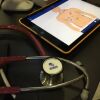I dream of a future where we can stop talking so much. The only way this dream can be realized is if we develop the technology to wirelessly transmit all physiological parameters to the receiving hospital. This should not be rocket science; all the pieces of this puzzle are here right now. We can get wireless broadband at a coffee shop and we have multi-parameter monitors. But what we are doing now is really a little primitive for 2009.
The first two minutes of every EMS radio report is a litany of basic vital signs. If anything changes, we need to radio back in and verbally update them. Please keep in mind a busy ER nurse could be overwhelmed. While you are prattling on about a guy with a broken ankle, he or she may have one patient in the ER crashing, one needing to go to X-ray, two more that need labs drawn, and one more on the way in the door. They just don’t have much time to spare. They can monitor multiple patients at a time in the emergency department, so why shouldn’t they be able to monitor yours, too?
As it stands right now, nurses speak with each inbound ambulance, taking precious minutes away from ER patient care to listen to mostly a bunch of numbers. My dream is that ERs could see all our field data like SAO2, ETCO2, BP, pulse, respiratory rate, ECG, everything — right on the screen when I call up. Then I would only need to talk about what I think is wrong, what I have done, and what I want to do about it next. That way this whole conversation takes maybe 40 seconds and not four minutes. They should even be able to see your calculated time of arrival by GPS. That sure would redistribute one heck of a lot of nursing hours.
Most modern ERs have some type of bedside monitoring system. The patients’ vital signs, ECG, and much more are all displayed on a monitor screen in a central workstation. But EMS providers still must talk through this basic information verbally over a radio to the hospital. Worse, when we do talk about telemetry in EMS, it’s usually just about the ECG. That is only one part of the important data that we want to share. I can buy a cell phone that talks to satellites in orbit, but I can’t get a BP machine to talk to the ER. I don’t understand why.
The good news is most parts of the solution already exist. Systems like the Carepoint Workstation from General Devices are now available for receiving data in the Emergency Department. It can receive almost any kind of data, but we just can’t send it all to them yet.
I’m seeing signs that this is about to change. The new IntelliVue MP2 Multi-parameter monitor from Philips has an inviting-looking LAN output on the back of the charging unit. Many of the leading monitor/defibrillator companies are well on their way towards making much more than ECG data available to the ER. Most of the industry defibrillation leaders already offer options of built-in blood pressure, ETCO2, SAO2 and more. I think it’s just a matter of more EMS providers asking for the ability to send it with their ECGs.
If everybody keeps asking for full data transmission capability, then maybe one of these bright device companies will finally give it to us. I would want every single medical device in the back of my ambulance to be able to send its information to my destination. Ideally, even devices which are physically separate should be able to “talk” to a central hub or ambulance repeater. Sounds like a good application for Bluetooth, doesn’t it? If your BP monitor, pulse oximeter, end-tidal CO2 monitor, cardiac monitor, and ventilator could all transmit wirelessly on a local network, we could integrate all this information and send it to the hospital. We can physiologically monitor an astronaut thousands of miles away, moving at unbelievable speeds. We should be able to monitor a patient 20 blocks away moving at 35 MPH.
I only want to talk to the base about what’s wrong, why, and how we are going to make it better. I want them to know the same second I do when very bad things are happening to my patient. That way when they do get the microphone keyed, it’s to give me the help I need. Let’s save voice communications bandwidth for issues that really need to be verbalized. Then we could all do a much better job, and much more efficiently.
One way to stay abreast of future developments in this field is by subscribing to a brand new Telemedicine Newsletter — called LifeBot. The first issue just hit the streets this week. You can also always stay in touch with the latest new EMS technology developments right here at EMS1.com.












